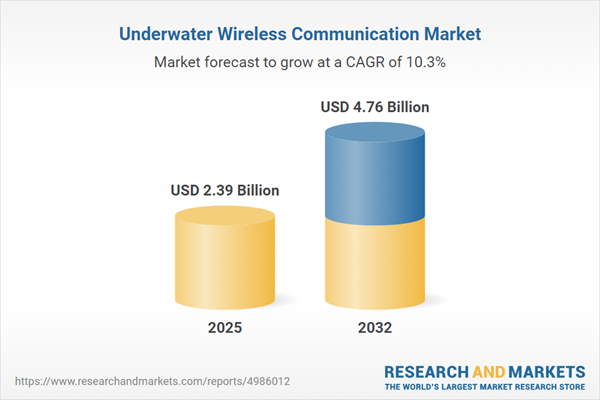Speak directly to the analyst to clarify any post sales queries you may have.
The underwater wireless communication market is poised for significant advancements, as organizations seek more resilient and high-performance data exchange capabilities beneath the ocean’s surface. Critical for sectors ranging from defense to energy, underwater wireless communication is evolving to address the increasing complexity of subsea operations and environmental monitoring.
Market Snapshot: Growth Drivers and Opportunity Landscape
The Underwater Wireless Communication Market grew from USD 2.16 billion in 2024 to USD 2.39 billion in 2025. It is expected to continue expanding at a compound annual growth rate (CAGR) of 10.33%, reaching USD 4.76 billion by 2032. Factors influencing this momentum include a heightened need for real-time subsea monitoring, advances in hybrid acoustic and optical technologies, and broader investments in offshore infrastructure across global regions.
Scope & Segmentation: In-depth Analysis of the Underwater Wireless Communication Market
This report provides a detailed examination of the underwater wireless communication ecosystem, highlighting segments and current technology trends:
- Component: Modems, Networking Solutions (including Routers and Switches), and Transceivers (with options for Multi Band and Single Band communication).
- Deployment Depth: Deep Water applications requiring durability and long-range coverage, and Shallow Water deployments emphasizing high-speed data for coastal and infrastructure monitoring.
- Communication Technology: Acoustic Communication for enhanced range, Optical Communication for high-data-rate transmission in clear water, and Radio Frequency Communication tailored for specific subsea operations.
- Application: Environmental Monitoring, Military & Defense (e.g., Diver Communications, Subsea Surveillance), Offshore Oil & Gas (including Platform-To-Platform and Platform-To-Subsea connectivity), Scientific Research, and Underwater Vehicles & Drones (encompassing both AUVs and ROVs).
- Geography: Americas (including North America and Latin America), Europe, Middle East & Africa, and Asia-Pacific, with comprehensive coverage of relevant countries and subregions.
- Leading Companies: Teledyne Technologies Incorporated, Kongsberg Gruppen ASA, Sonardyne International Ltd, EvoLogics GmbH, Subnero Ltd, Water Linked AS, Nortek AS, Saab AB, Aquateknik AS, and MacArtney A/S.
Key Takeaways: Strategic Insights for Decision-Makers
- Innovation is shaped by collaboration between equipment manufacturers, researchers, and regulatory agencies, leading to more robust and interoperable communication networks.
- Deployment strategies must account for unique environmental factors, balancing device autonomy, latency, and resilience to suit mission-critical applications across diverse marine conditions.
- Region-specific drivers, such as defense upgrades in the Americas and deepwater energy projects in the Middle East, dictate technology adoption and partnership structures.
- Energy efficiency has become an operational imperative, resulting in the integration of energy harvesting and the adoption of low-power electronic components to extend subsea asset lifecycles.
- Flexible network architectures—combining acoustic, optical, and radio technologies—are enabling greater adaptability and coverage, especially in complex or changing underwater environments.
Tariff Impact: Strategic Moves Amidst Policy Uncertainty
Recent United States tariffs have complicated sourcing decisions and elevated component costs, prompting vendors to diversify their supply chains, prioritize domestic manufacturing, and pursue modular designs for agile adaptation. Established alliances now seek not only to secure critical components but also to advocate actively for favorable regulatory treatment of essential subsea communication equipment.
Methodology & Data Sources
The research methodology integrates comprehensive secondary research with direct expert interviews and triangulation of academic, vendor, and regulatory data. Analysis is validated using field trial reports and cross-segment case studies, ensuring all findings are both reliable and relevant in a fast-evolving market.
Why This Report Matters
- Empowers business leaders to align technology investment with their operational priorities, informed by regional and application-driven nuances.
- Delivers actionable intelligence for navigating supply chain volatility, regulatory shifts, and rapidly changing communication standards.
- Supports strategic planning with robust segmentation, competitive analysis, and insights into innovation roadmaps.
Conclusion
This report provides a holistic perspective on the underwater wireless communication sector, offering clarity on emerging technologies, competitive strategies, and new market opportunities. Leaders can leverage these insights to make informed, forward-looking decisions in a dynamic subsea environment.
Additional Product Information:
- Purchase of this report includes 1 year online access with quarterly updates.
- This report can be updated on request. Please contact our Customer Experience team using the Ask a Question widget on our website.
Table of Contents
3. Executive Summary
4. Market Overview
7. Cumulative Impact of Artificial Intelligence 2025
Companies Mentioned
The companies profiled in this Underwater Wireless Communication market report include:- Teledyne Technologies Incorporated
- Kongsberg Gruppen ASA
- Sonardyne International Ltd
- EvoLogics GmbH
- Subnero Ltd
- Water Linked AS
- Nortek AS
- Saab AB
- Aquateknik AS
- MacArtney A/S
Table Information
| Report Attribute | Details |
|---|---|
| No. of Pages | 189 |
| Published | October 2025 |
| Forecast Period | 2025 - 2032 |
| Estimated Market Value ( USD | $ 2.39 Billion |
| Forecasted Market Value ( USD | $ 4.76 Billion |
| Compound Annual Growth Rate | 10.3% |
| Regions Covered | Global |
| No. of Companies Mentioned | 11 |








